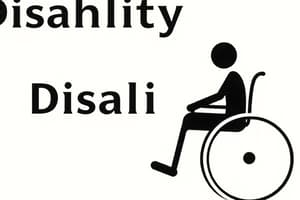Podcast
Questions and Answers
What percentage of the world's population is estimated to experience disability?
What percentage of the world's population is estimated to experience disability?
- 10%
- 12.29% (correct)
- 15%
- 18%
What are the primary factors contributing to the increasing number of people with disabilities?
What are the primary factors contributing to the increasing number of people with disabilities?
- Genetic mutations and natural disasters
- Increased access to healthcare and medications
- Improved diagnostic technologies and awareness
- Rise in chronic health conditions and population ageing (correct)
Which of the following is NOT a type of disability mentioned?
Which of the following is NOT a type of disability mentioned?
- Nutritional disability (correct)
- Chronic illness
- Speech and language disability
- Memory loss disability
In what context is disability considered a human rights issue?
In what context is disability considered a human rights issue?
How does disability relate to poverty in lower-income countries?
How does disability relate to poverty in lower-income countries?
Which of the following accurately describes invisible disabilities?
Which of the following accurately describes invisible disabilities?
What is a characteristic of schizophrenia?
What is a characteristic of schizophrenia?
Which of the following examples is classified under developmental conditions associated with childhood?
Which of the following examples is classified under developmental conditions associated with childhood?
What does the ICF emphasize regarding disabilities?
What does the ICF emphasize regarding disabilities?
Which of the following is NOT a type of disability mentioned?
Which of the following is NOT a type of disability mentioned?
What defines activity limitation in the context of health?
What defines activity limitation in the context of health?
Which of the following is an example of functional impairment?
Which of the following is an example of functional impairment?
What is a participation restriction?
What is a participation restriction?
What is the purpose of the International Classification of Functioning, Disability and Health (ICF)?
What is the purpose of the International Classification of Functioning, Disability and Health (ICF)?
Which of the following best describes functional impairments?
Which of the following best describes functional impairments?
How can environmental factors impact health, according to the ICF?
How can environmental factors impact health, according to the ICF?
Which term best describes a situation where an individual cannot walk due to a medical condition?
Which term best describes a situation where an individual cannot walk due to a medical condition?
What term refers to a person’s involvement in a life situation?
What term refers to a person’s involvement in a life situation?
Which category of disability involves conditions like upper limb disability and manual dexterity issues?
Which category of disability involves conditions like upper limb disability and manual dexterity issues?
How can spinal cord injuries lead to disability?
How can spinal cord injuries lead to disability?
What distinguishes a complete spinal cord injury from an incomplete one?
What distinguishes a complete spinal cord injury from an incomplete one?
What is a potential cause of brain disabilities?
What is a potential cause of brain disabilities?
What is true about disabilities in general?
What is true about disabilities in general?
What is a common misconception about disabilities?
What is a common misconception about disabilities?
Which of the following is NOT classified as a mobility impairment?
Which of the following is NOT classified as a mobility impairment?
Which of these can be considered a hidden disability?
Which of these can be considered a hidden disability?
What can cause mobility disabilities?
What can cause mobility disabilities?
Flashcards are hidden until you start studying
Study Notes
Disability Definition
- Over 1 billion people experience disability globally, representing 15% of the world's population
- In Turkey, 12.29% of the population, or roughly 190 million people aged 15 and older, have significant difficulties with functioning, requiring healthcare services.
- The number of people with disabilities is rising due to increased chronic health conditions and an aging population
- People with disabilities face barriers, stigma, and discrimination when accessing health and health-related services.
- Disability is a development priority due to its high prevalence in lower-income countries and its connection to poverty.
Classification of Disabilities
- Types of disabilities include physical and mental impairments affecting daily activities.
- Classifications of Disabilities:
- Mobility and Physical Impairments:
- Upper and lower limb disabilities, manual dexterity issues, and coordination problems
- Can be inborn, acquired with age, or caused by illness or injury, such as a broken bone
- Spinal Cord Disability:
- Spinal cord injuries (SCI) can lead to lifelong disabilities, often resulting from accidents.
- Injuries can be complete or incomplete, affecting messages conveyed by the spinal cord.
- Birth defects can also cause spinal cord disability.
- Head Injuries - Brain Disability:
- Brain injuries can range in severity from mild to severe.
- Mental health impairments encompass psychiatric problems or illnesses:
- Personality disorders: deeply ingrained patterns of behavior causing significant impairment
- Schizophrenia: characterized by disruptions in thinking, mood, and behavior
- Invisible Disabilities:
- 10% of people in the U.S. have a medical condition categorized as an invisible disability.
- These conditions are not immediately apparent to others.
- Mobility and Physical Impairments:
Causes of Disability
- Conditions present at birth:
- Can affect functions later in life, including cognition, mobility, vision, hearing, and behavior.
- These conditions may be caused by:
- Single gene disorders (e.g., Duchenne muscular dystrophy)
- Chromosome disorders (e.g., Down syndrome)
- Maternal exposure to infections (e.g., rubella) or substances during pregnancy (e.g., alcohol or cigarettes)
- Developmental conditions apparent during childhood:
- Examples: autism spectrum disorder and attention-deficit/hyperactivity disorder (ADHD).
- Injuries:
- Examples: traumatic brain injury (TBI) or spinal cord injury (SCI).
- Longstanding conditions:
- Example: diabetes, which can cause disabilities like vision loss, nerve damage, or limb loss.
- Progression of conditions:
- Progressive (e.g., muscular dystrophy)
- Static (e.g., limb loss)
- Intermittent (e.g., some forms of multiple sclerosis)
Activity and Participation
- The International Classification of Functioning, Disability and Health (ICF) includes:
- Learning and applying knowledge
- Managing tasks and demands
- Mobility: moving the body, handling objects, using transportation
- Managing self-care tasks
- Managing domestic life
- Interpersonal relationships and interactions
- Major life areas: education, employment, finances
- Community, social, and civic engagement
Types of Disabilities
- Disability is not a disease, but a health condition limiting life.
- Permanent Disabilities: Conditions individuals are not expected to recover from.
- Temporary Disabilities: Illnesses or injuries preventing participation in routine activities
- Functional Decline: Disability is often measured by limitations in daily activities, categorized as:
- Limitations in Activities of Daily Living (ADLs)
- Limitations in Instrumental Activities of Daily Living (IADLs)
Outcomes
- People with disabilities can lead healthy lifestyles.
- Disability Inclusion:
- Including people with disabilities in daily activities.
- Providing accommodations to reduce activity limitations and participation restrictions.
Studying That Suits You
Use AI to generate personalized quizzes and flashcards to suit your learning preferences.




